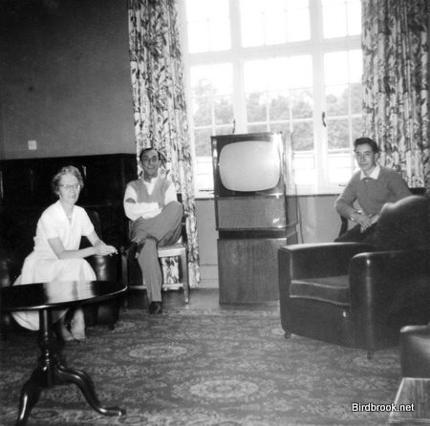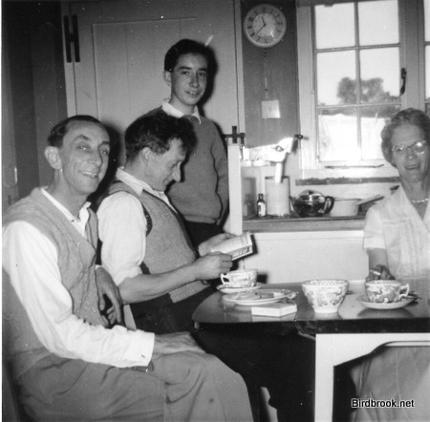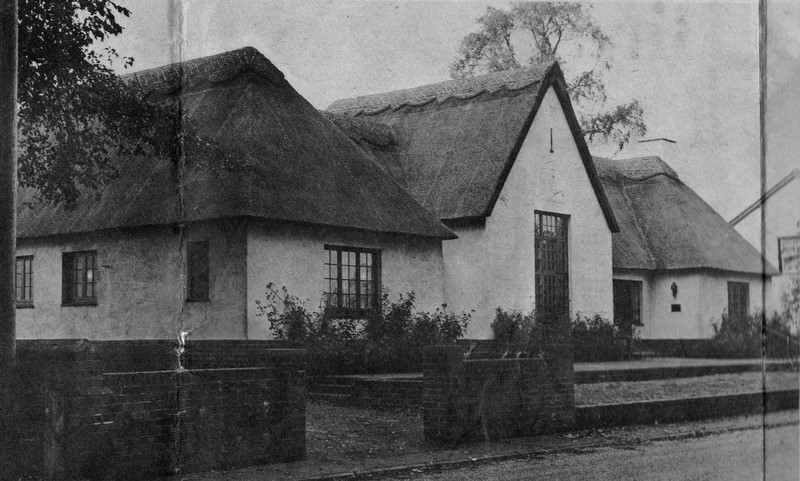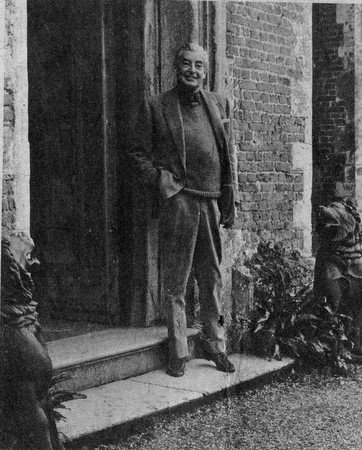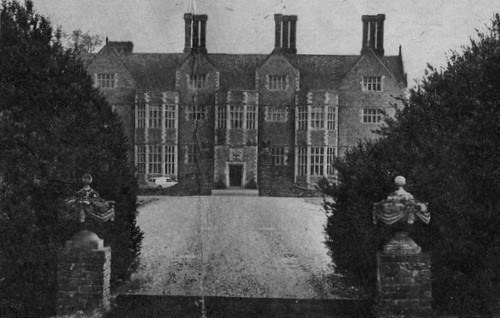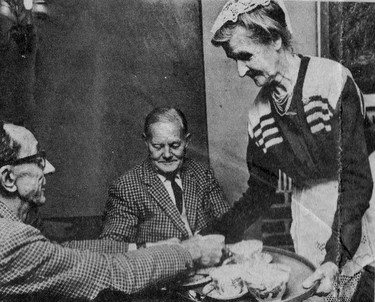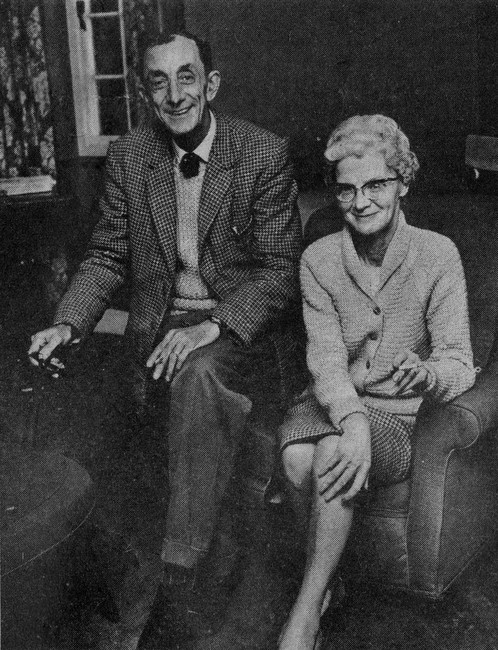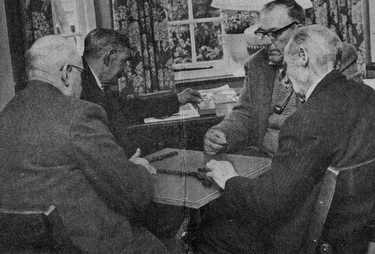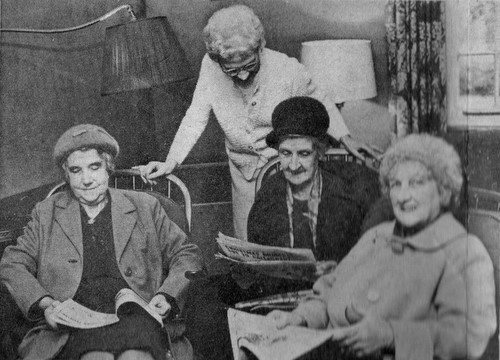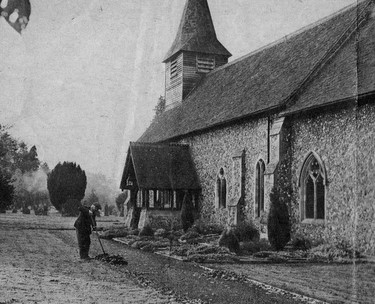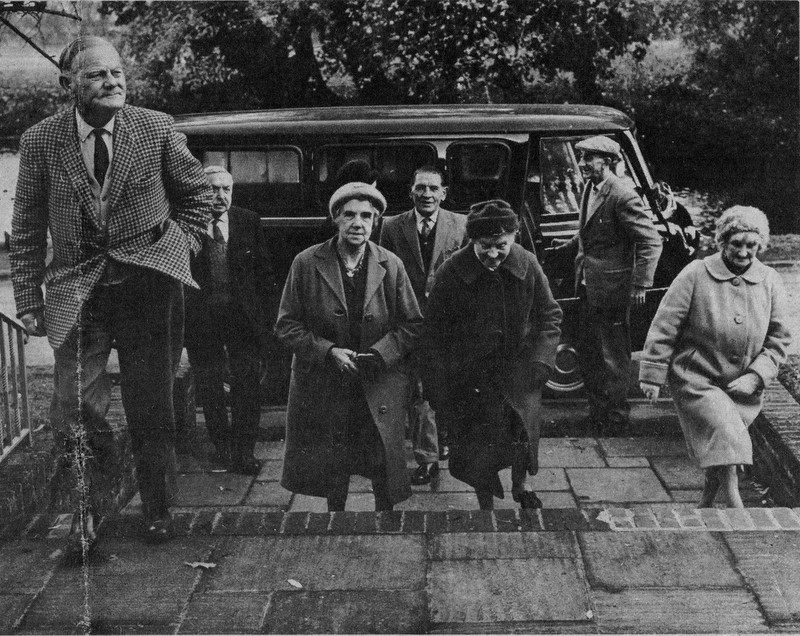The Community House

The Community House was build in 1958, designed by Michael Tapper & J. Anthony Lewis with the interior by David Hicks and funded by Mr. & Mrs. Bryces of Moyns Park. It was designed to be in keeping with the rest of the village with its Norfolk thatched roof and plastered walls, and consisted of hall, reading room and caretaker's flat. Mr. & Mrs Bryce set up an investment trust to fund the running and maintanence of the house. The fund got into difficulties in the 1970's, see newspaper report below, today their is no caretaker and the flat is rented out. The village bowling green lays behind the house.
1958/59 inside the main room of the 'new' community house, Mr & Mrs Burgess the first caretakers. Look at the size of the telly! | Inside the kitchen, Mr & Mrs Burgess and reading the book Fred Taylor who lived in Halfway Cottages. Pictures by David James. |
The following article is dated January 13th ,1967, and comes from the magazine section but it does not give the name of the paper. Anyone know which paper? Cutting from Mary Sare.
Birdbrook a Village in Clover A church free of financial worry, a house endowed as a centre for social activities - these two golden gifts make this the luckiest village in Essex. Geoffrey Root tells the story. Laurie Honeyball took the photographs. |
|
An attractive building in traditional Essex style, with pargeting on the walls, and a reed thatched roof, the Community House at Birdbrook has a rose garden at the front, and a bowling green at the rear. |
Go into almost any village in Essex and the chances are you will find a gallant band of voluntary workers trying every method, new or old, to raise money. And nearly always the money is for one of two causes, the parish church or the village hall. As they rush from one fund-raising event to another these good citizens must sometimes wonder what life would be like if there were no medieval church or Victorian school turned village hall endlessly draining away the profits of their labours. One village where the parish church and the community centre are self-supporting and even well-to-do, instead of down at heel and dependant on charity, is Birdbrook. The tiny village of less than 300 people, right on the north-west border of Essex, has a parish church so well off that they give the Sunday collections away, and a community house which is endowed by an Anglo-American foundation with money enough to provide a centre for village activities, a bowling green, and even a mini-bus to bring in those who live in the outlying districts. The community house, a unique concept, is the brain-child of Mr. and Mrs. John Bryce, who live at Moyns Park, an Elizabethan mansion whose surrounding acres occupy a large part of the parish. The wealthy Bryces took over the estate in the middle '50's, and have restored it to its former glory. The house has sentimental family connections for Mr. Bryce. He was born there when it belonged to his grandmother, Mrs. Ives. Her husband, General Ives, brought it from a very distant relative who was descended from the original builder of the house in 1570. Mr. Bryce breeds racehorses at the Moyns Park Stud. His wife races them, and a very successful partnership it has been. |
John Bryce, horse-breeder and philanthropist, at the door of his Moyns Park home. |
Historic Moyns Park, Birdbrook, home of Mr. and Mrs, J.F.C. Bryce was built in 1570. From here the idea of a village community house was launched. | Eighty Winners In the comparatively short space of eight years since the stud was started they have bred 27 horses, which have won 80 races, including 19 last year. Mounts from the stud have won a total of £132,000 in prize money, including the world's most valuable race, the Arc de Triomphe, worth £60,000. Mrs. Bryce won the Lincoln last year with Riot Act. The Bryces support their unique experiment in village life through the Bryce Foundation. this Anglo-American charitable foundation, formed by Mr. Bryce and his wife, spends money on philanthropic objectives, both in Britain and is US. Describing the thinking that lay behind Birdbrook Community House, Mr. Bryce says "We thought that in this very rural part of Essex people sometimes led lonely and possibly unhappy lives in their last few years, with very few friends." |
They felt it would be a fine thing if there could be a place in the village where everyone could meet. They wanted it to be like a club, to which everyone in the neighbourhood could belong, where they could walk in and out as they pleased, meet their friends and hold social events. So the community house was born. It opened just over eight years ago. Designed in traditional Essex style, with pargeted walls and a reed thatched roof, it stands near the old schoolroom in the village street, looking across the village pond. In front is a rose garden and at the back a fine bowling green. Inside there is a reading room, with all the latest magazines and newspapers, and a larger room for games and social events. The atmosphere is like that of a well-to-do club, with carpeted floors, central heating, TV, and furnishings which would do credit to a high-class hotel. There is a radio and record player, and there are no formalities, no subscriptions, nothing to pay. |
Mrs. Emily Hayes serves tea and biscuits at the community house. |
|
Mr. and Mrs. J. Burgess left a flat in Fulham eight years ago to run the Community House. | From London The community house is looked after by Mr. and Mrs. S.J. Burgess, who live in the flat attached. They came to this remote part of Essex from a flat in Fulham. Mr. Burgess had a job on the "Sunday Times", and got the job at Birdbrook through Ian Fleming, creator of the James Bond, who was working on the paper at the time, and was an old friend of the Bryces. Much of the success of the venture is due to the work of these two cheerful Londoners. Since the house was first opened it has become the centre of village life, with events such as whist drives, rummage sales, WI and Legion meetings all held here. Friday the older people of the parish meet there for a cup of tea, a game of cards or dominoes and a chat. The Bryce Foundation has also provided a mini-bus which Mr. Burgess runs round the village bringing in those who live in the outlying parts of this scattered parish. Funds for Others With nothing to pay, and no bills coming in, the people of Birdbrook still have a few fund-raising events, for their social value, and to raise money either for outside causes, such as the Aberfan Disaster fund, or for such things as the children's Christmas party. An annual flower show is also staged in the house. The Birdbrook experiment was followed by a second community house, at Belchamp St. Paul. Opened about three years ago, the Belchamp house embodies lessons learnt from its predecessor. It is slightly larger, and has a tennis court for the younger generation, instead of the bowling green which at Birdbrook is the home of a flourishing bowls club. Although the Birdbrook house is an undoubted success, Mr. Byrce remarks that social conditions have changed in the last ten years or so since the idea was first considered. He feels there is not such a need now as there was then. |
Other competing ideas, and the spread of TV, greater affluence, and the increasing number of cars have all widened the horizons of village living more than anyone would have guessed ten years ago. He thinks unlikely they would build another at the present time, even if the money was available. Just down the village street from Birdbrook's Community House stands the Parish church of St. Augustine, neat and tidy in its well-kept churchyard. Golden Surprise By a curious trick of fate, at about the same time as the community house was opened this tiny village had another golden surprise. When the widow of a former rector,Mrs. Edith Clara Young, died in a Cambridge nursing home, in October 1958, she left £77,588. The residue went to the rector and church-wardens of Birdbrook, where her husband Dr. Alfred Young had been incumbent from 1910-1940. |
For the menfolk a friendly game of dominoes is popular. |
There are papers and magazines for everyone to read, or they may just pass the time in friendly chat. | The churchwardens' first task was to tackle the problems they shared with nearly every country parish. Number one priority was church heating, and an oil-fired system was installed; the fabric of the church repaired; the wooden spire re-shingled; the roof retiled; and the interior redecorated; pews re-polished and new carpets laid. Outside, the churchyard was cleaned up, and altogether nearly £8,000was spent - all out of income. With the best part of £40,000 invested the church has an income of something like £2,000 a year or more. Under the terms of the will it has to be spent in the parish, so no appeals from envious less well-off neighbours can be acceded to. In Memory With the church put to rights, the rector and churchwardens decided to perpetuate the memory of their benefactress by installing a magnificent stained glass window at the east end of the church. When Mr. G.E. Unwin completed 60 years' service as churchwarden this year, another fine stained glasswindow was erected to mark the event. |
The old schoolroom has been renovated and put into use as a clubroom for the youngsters, and now a new altar is being installed and the sanctuary repannelled. Later the parish hopes to part with its present organ, and install a new Hammond instrument, at the same time clearing the chancel and re-arranging the seating to better advantage. Outside the newly refurbished church is a churchyard kept like a gentleman's garden. It has the attention of a gardener for a day a week to trim the neat lawns and weed the paths. With the burden of church upkeep off their shoulders what do the church-goers of Birdbrook do with their money? "We don't have coffee mornings and bazaars and fetes and sales of work" says the Rector, Rev. Fred Cordingley, "but we are pretty good on special collections, and we give all our Sunday collections away." One Sunday each month the collection goes to the Sue Ryder Homes at Cavendish, just across the Suffolk border. But most of Birdbrook's offerings go further afield, to the Children's Society, and to the CMS and other missionary societies. Relieved of the pressing problems of day-to-day giving, the people of this tiny village are all the more ready to support good causes in the wider world. In the meantime they quietly enjoy their good fortune. |
The parish church at Birdbrook is so rich it has a part-time gardener to keep the churchyard neat and tidy. Mr. William Underwood rakes up autumn leaves. |
A mini-bus travels round the district to bring people to the Community House. |
The following comes from 'Birdbrook with Sturmer Parish News', for November 1967:- MR. AND MRS. BURGESS Among the removals that could be reported this month is one you probably did not expect. Mr. and Mrs. Burgess are leaving the Community House to live in the house recently occupied by young Mr. and Mrs. Whybrow, in Station Road. This is somewhat misleading statement as is seems to imply they are giving up their work at Birdbrook Community House. Nothing could be further from their thoughts they merely desire a bit more elbow room in their living quarters. |
The following article comes from the Haverhill Echo, November 22nd, 1973
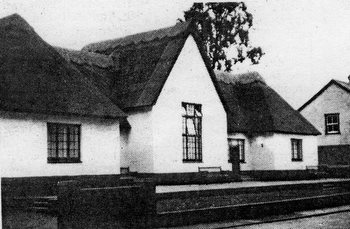 | Village centre trust cash is slashed Because of the present uncertainty of the American economy severe cuts are being made in the trust funds available for the maintenance for the community houses at Belchamp St Paul and Birdbrook (pictured). The centres were set up more than 15 years ago by London financier Mr John Bryce of Moyns Park, Birdbrook, and his American wife, Jo. A trust to provide funds for their maintenance was also provided by Mr and Mrs Bryce helped by prominent American businessmen. Mr Harold Jackson, secretary at Moyns Park, said that in the future the trust would only be providing £1,000 a year for each house. At present it cost £5,000 a year to run the two. Trust funds were invested in America, said Mr Jackson, but present returns on the capital were low which meant less cash for distribution. Mr Jackson added: "We hope to maintain the subsidy at £1,000 for each house for the foreseeable future and if the financial situation improves we may be able to increase the payments again." The chairman of the Birdbrook trustees, the Rev B.W. Ottaway said a meeting would be held next week to discuss how the community house should continue. |
A recent important use of the Community House.
Click here to return to Westside of The Street
